WinHEC 2005: Coverage Wrap
by Derek Wilson & Jarred Walton on April 29, 2005 2:00 PM EST- Posted in
- Trade Shows
More from the Expo Floor
While the show floor certainly wasn't as big as what we're accustomed to seeing at E3 or some of the other shows, there were still a few other items that we found interesting. There isn't really a central theme to this, so just pretend you're walking around the exhibition floor with us bouncing from networking to PCI Express to servers, all the while passing LCD displays showing DVD and HD content. And just for the record, CRTs are basically dead. There wasn't a single CRT present at WinHEC, and no one is interested in trying to improve the technology. Even if you love your current 22" CRT, we expect by the time you're ready to upgrade, any CRTs will be at least as old as what you're already using. That tangent aside, here's some of the other exhibits we saw on the floor.Alienware Gaming Zone
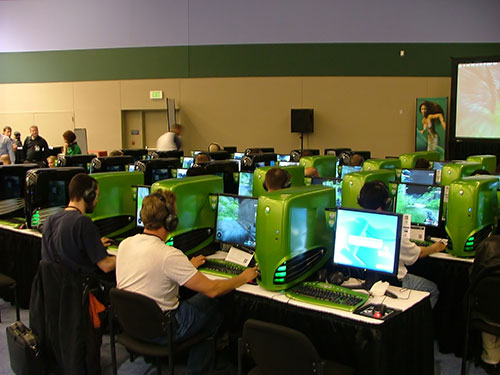
There was a large gaming arena set up in one corner with 30+ Alienware systems. All of the systems were running XP-64 with a 64-bit build of Far Cry. System hardware consisted of Athlon 64 4000+ CPUs with 1GB of RAM and GeForce 6800 Ultra graphics cards. The two game servers were running SLI with (we think) 2GB of RAM in spectator mode. We couldn't really see any difference between the 64-bit version of Far Cry and the "old" 32-bit version, but we were told that it was "substantially faster". Hopefully, we can get the test version back into our labs to validate - or disprove - these claims. We didn't bother participating in the competition where the winner walked away with some hot hardware, but [*cough*] we figure it's nice to let someone else win now and then.
Intel's Dual Core Itanium (Montecito)
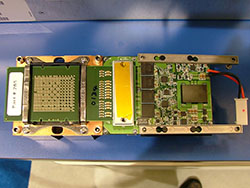 |
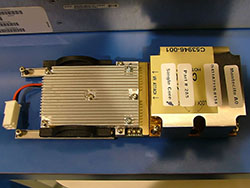 |
| Click to enlarge | |
As far as we're aware, this is the first demonstration of Montecito running at full clock speeds (2.0 GHz). We might have that wrong - on both the clock speed and the "first" claim - but whatever the case, Intel did have a Montecito server present. Just to recap, the Itanium 2 Montecito chip is a dual core processor with SMT/HyperThreading on each core. It tips the scales at a mere 1.72 billion transistors, nearly fourteen times the size of the Prescott core (and made using the same 90nm manufacturing process). Of course, most of those transistors go to the 24MB L3 cache - we'd guess somewhere around 1.4 billion transistors just for the L3 cache and logic, if not more. Running in a dual socket motherboard, the result is eight virtual processors, as you can see in the following screenshot.
Intel's Pelston and Foxton Technologies
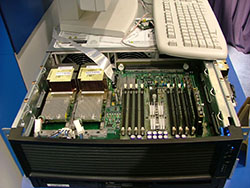 |
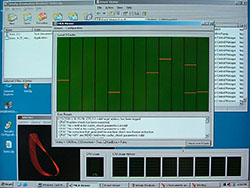 |
| Click to enlarge | |
The server was running the Itanium version of Windows (we're not sure if it was XP-64 or the older Windows for IA-64), but that wasn't really important. What was important was that the chips were up and running and Intel had a demonstration of some of the new technologies for the platform. One of the new technologies present in Montecito is called Pelston. The Pelston technology, if you haven't heard of it, is a way for Intel to increase the yield and reliability of the Montecito processors. With the massive L3 cache, it's pretty much inevitable that there will be defects. Pelston allows the processor to detect cache errors and deactivate the faulty cache lines. The "MCA Viewer" application in the above screenshot shows the results after a second system simulates the failure of various cache lines - 10 so far in the example. Those of you who might worry about the loss of performance with decreased amounts of cache, have no fear: Intel will replace chips that develop more than 90 faulty cache lines (less than 0.1% of the total L3 cache).
Another technology present in Montecito that we didn't see demonstrated is called Foxton. Foxton allows for dynamic overclocking of the processors if certain thermal and load conditions are met. With a sufficient cooling setup, the processors can run at up to 2.2 GHz, at least periodically. That's only a 10% overclock, and it's not even guaranteed, but it's interesting for an Enterprise Class server chip nonetheless. Again, Intel reiterated that Itanium is not a dead technology. They further elaborated that "there are technologies present in the Itanium platform that you can't get with Xeon." The real competition for Itanium 2 comes from IBM POWER5 and Sun ULTRASparc, and with a cost of around $5000 per Montecito processor, Intel is actually something of a "bargain" by comparison.
AMD's Quad Opteron
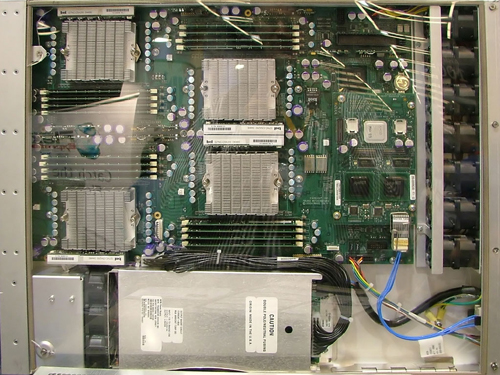
While we're on the topic of servers, AMD had the above Quad Opteron system running with 16GB of RAM (or possibly 32GB - we couldn't confirm the exact amount). It wasn't doing anything particularly useful at the time, and we couldn't determine if the system was using the new dual core Opteron chips or not. If it was, a "wrestling match" between it and the earlier Montecito server might have proved interesting. It might be difficult to setup an apples-to-apples test, however, as the Itanium does rather poorly when running x86 code and it doesn't support x86-64.










17 Comments
View All Comments
DerekWilson - Saturday, April 30, 2005 - link
heh ... not even the CPU editor has all the CPUs he needs. We've been passing our one set of dual core processors from both vendors around the globe. :-)JarredWalton - Friday, April 29, 2005 - link
The *official* plan is for Longhorn to be widely available by the holiday 2006 time frame (see day 1 coverage). However, I think XP-64 was supposed to be available over a year ago as well. Call me a skeptic....The point about going next year is that, from what I could tell, certain things are just repeated in slightly updated formats each year. Longhorn was discussed last WinHEC, and the information this time was simply a bit more concrete. There were still quite a few "this isn't yet finalized..." disclaimers throughout the presentations.
I suppose since I'm local to WinHEC (I'm in Olympia, WA), at the very least I'll be going to some of the MS events in the future. We'll have to see how that pans out. Maybe next time I can make it to the Sunday AMD Gaming gig and get a free Athlon 64 4000+? (Yeah, we missed out on that. Not that we don't have lots of hardware already, but having an extra CPU never hurts. Especially when you're not the CPU editor. Heheh)
PrinceGaz - Friday, April 29, 2005 - link
Fascinating. Probably the most relevent event report I've read. The IDF is interesting to see where the hardware is going, but it is the software that we use on a day to day basis, and what Microsoft are planning is likely to impact us the most in the next few years."At the end of the show, while we would definitely say that WinHEC doesn't have the appeal of Computex, E3, or some of the other larger shows, there was still plenty of good information to be found. Will we go again next year?"...
I can't believe you are even wondering whether to go again. Though if Anand is using his Mac all the time now and abandoned PCs, and those of you with PCs have switched from Windows to Linux, then I could understand your hesitation. I jest of course, but what happens with Microsoft is likely to be more important to the PC user than any hardware development, so there is no way you can neglect it.
I thought Longhorn was due out mid-2006, rather than "two years time". Longhron has seemed to be due out in "two years time" for quite a few years now, such that I wonder if it will ever actually arrive. And when it does arrive, will it actually contain many of the improvements originally touted over Windows 2000/XP (such as the central WinFS file-system which they decided would delay Longhorn too long). So are Microsoft officially saying 2007 is Longhorn year now?
Personally I'm in no hurry for Longhorn if it is crippled with DRM restrictions everywhere. The whole pointy of a PC is I can do what I wish with the media I have obtained, whether purchased or from other sources. I would say that being able to view perfect and complete "try before I buy" content has had the main effect with me of making me buy stuff I otherwise wouldn't have considered, rather than simply using it as an alternative to purchasing discs. Content protection that limits consumer choice (even if that choice includes free downloads) is and always has been detrimental to the industry.
JarredWalton - Friday, April 29, 2005 - link
DOS is still in use as a deployment tool. You can still license DOS from MS, but that will cease to be the case as of 2006. I work as an IT guy for a huge corporation, and our PC build process goes like this:1) Boot from floppy.
2) Select PC configuration.
3) Watch Drive Image clone the XP image to the HDD.
4) XP loads up and finishes the device enumeration, joins the appropriate domain, etc.
5) Choose SMS pacakages and wait.... (The final stages of the build process can take as long as an hour or two, depending on the SMS packages that are selected for installation.)
The problem is that getting DOS network drivers as well as support for newer technologies (SATA) is getting more and more difficult. The whole setup process would be more streamlined if HQ personnel didn't have to worry about DOS. I would wager that we'll still continue to use DOS and Drive Image for at least another 5 years, just because that's the way this corporation is, but it's nice to know that eventually they'll be forced to update the process to something that is hopefully faster and more robust.
icarus4586 - Friday, April 29, 2005 - link
"R.I.P. MS-DOS, 2005"This part of the article doesn't make much sense. The huge majority of Windows machines are either 2000 or XP, both of which are NT. NT does not run on DOS. MS-DOS was dead with WinME, and should have been dead far before.
ProviaFan - Friday, April 29, 2005 - link
Interesting stuff... Out of all of it, I found the (U)EFI coverage to be most intriguing, since normally the BIOS is one of the least represented PC components in computer news coverage. ;)stephenbrooks - Friday, April 29, 2005 - link
"One giant Microsoft fest"?? That got me saying "Ewww!" before I started the article. XD Images of hordes of Barney ActiMates™ coming to play with me came to mind.